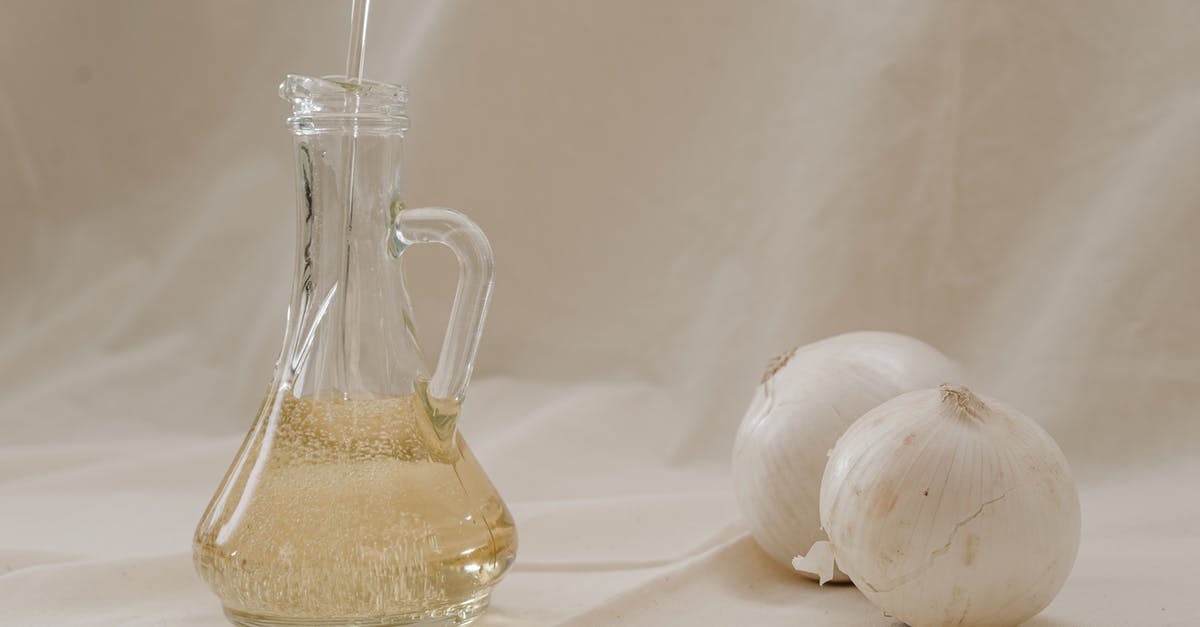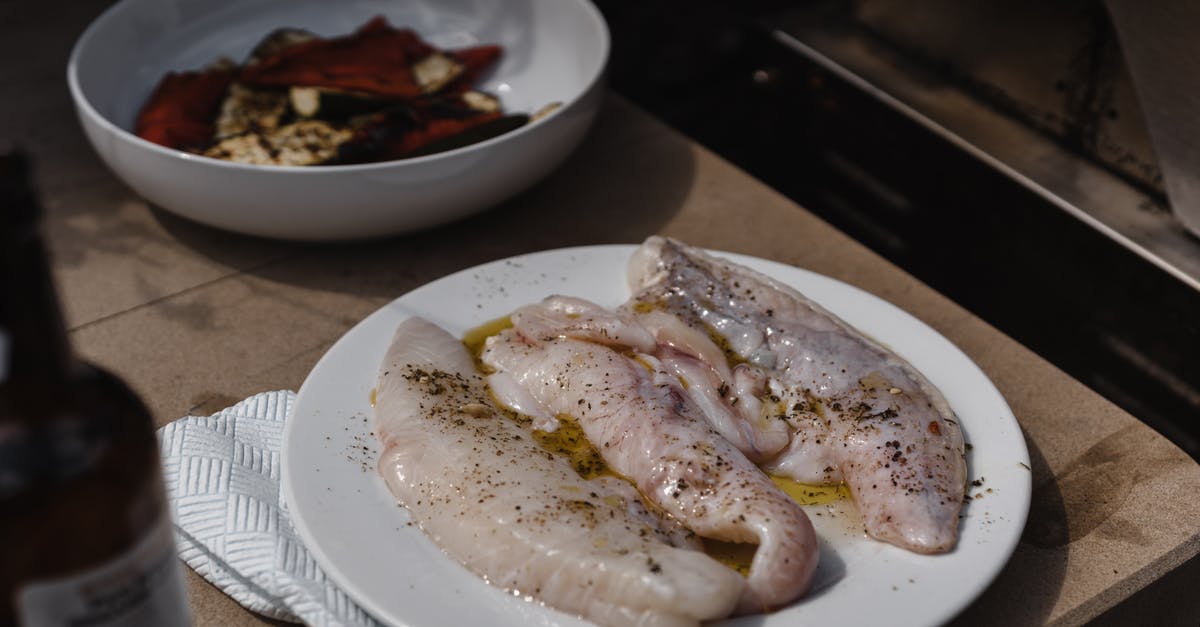What type of vegetable oil should I use for tempura?

If I want to make a really superior vegetable or seafood tempura, what kind of oil should I use, and what temperature should I heat it to?
I've been using refined peanut oil (Lion & Globe brand) and heating it to around 375F. However, the results haven't been as good as I'd like them to be. Would using a different type of oil help?
Best Answer
In my experience at expensive tempura restaurants, sesame oil is almost always used at least as part of the blend, but my understanding is that it is not the roasted kind, which has far too low a smoke point. I've been to a restaurant in Izu, now closed, where it was obvious because we were seated right in front of the fryer and the smell was quite noticeable, and the fancy place I went to in Tokyo was apparently using sesame oil as well, but they had more effective ventilation, so it was mostly obvious from the flavorfulness of the results. I've seen unroasted sesame oil in middle-eastern markets and I know some companies sell it in the US, so it is obtainable, and I've seen it at about $40/gallon on Amazon. I also know from experience that a blend of the roasted sesame oil and neutral, high-smoke-point oil will have a higher smoke point than just straight roasted sesame oil, and will add flavor, so it's at least possible that some people do that.
At home and at inexpensive restaurants, other vegetable oils are frequently used, and there's a simple tempura set that you can buy as a gift pack that I've seen used as a winter gift. This is usually cottonseed oil or a blend. In some regions, an ambiguous blend called "salad oil" is commonly used. It is not unheard of to use tea seed oil (camellia), which is increasingly available in the US at Asian markets (when I ran a specialty import business, I used to sell sell some that a Chinese tea importer was purchasing until he shifted his focus to larger packages suitable for restaurant use).
The Japanese entry for tenpura on Wikipedia confirms that a custom blend of sesame, cottonseed and other oils is often used at tempura shops. The Tokyo style and Kansai style is a bit different, with many Tokyo shops serving a darker version thanks in part to sesame oil and egg, and Kansai region versions leaning a bit whiter thanks either to using neutral vegetable oils or lack of egg.
I've used canola oil but it tends to leave an unpleasant aroma in the air, especially after the second use. If I were in the US and on a budget, I'd probably choose peanut oil, but it will taste different than most of what I've seen in Japan. I doubt that I've ever encountered peanut oil-fried tempura in Japan, though there's a chance I just didn't notice.
In practice, I've found that the most important thing to get good results from homemade tempura is to prevent overloading the fryer, because the temperature will drop too quickly. This is true for other kinds of fried goods as well, but is far more important for tempura because the coating should be fairly thin. As an unpracticed amateur, I've found that using a modest amount of katakuriko or cornstarch in the flour blend helps produce crisper results.
It's fairly difficult to get an assortment of different items to be ready at the same time, so consider making it in "courses" if you want flawless results, or make only one or two items at a time. Tempura restaurants tend to have wide, slightly shallow fryers, whereas most fryers meant for western deep-frying tend to have several stations of deep pots, since it's ok in many cases for things to be submerged, like when making french fries. It's quite unusual for tempura to be completely submerged.
Edited to add: Assuming you're coating with a batter (there are some types that are dusted with flour or katakuriko rather than a full batter), I get far better results by keeping the batter (or the flour) very cold.
Many years later edit, since I live in Japan now and occasionally buy prepared "tempura flour": I just wanted to note that, looking at the ingredients in tempura flour sold in Japanese supermarkets for home cooks wanting to make tempura here, baking powder is typically in the mix. I have added it occasionally with plain flour in the US depending on how important crisp results were to me, but if your primary issue is textural it may be worth a try. I don't think it's as much baking powder as "self-rising flour" would contain, but I'm not sure. I will say that in a pinch, when I was low on regular flour, I used tempura flour in scones and got acceptable results, so it may be "just enough" to cause some carbon dioxide explosions that produce a leavening effect.
Pictures about "What type of vegetable oil should I use for tempura?"



Quick Answer about "What type of vegetable oil should I use for tempura?"
Use vegetable oil for frying tempura — corn, canola, safflower or peanut, but not olive oil. Sesame oil is highly fragrant and adding a couple of tablespoons or more can add its perfume to your tempura. You can reuse the oil a couple of times.How To Make Tempura At Home
More answers regarding what type of vegetable oil should I use for tempura?
Answer 2
Peanut oil is good although it is not a cooking oil that is used a lot in Japan. I have never seen or tasted tempura fried in sesame oil. Traditionally, sesame oil is used in small quantities for flavouring and aroma, not usually for deep frying. However, hooray for experimentation! As long as the final product tastes good. As mentioned, most any oil that can be used for deep frying is acceptable for tempura. I prefer corn or canola oil. It is best to use a thermometer to keep your temperature consistent at around 350° F (not more than 360° F) which will help keep your tempura the same colour and crispness. It's also important to keep your batter cold (use cold water and refrigerate) so that the batter doesn't absorb too much oil and stays crispy. The batter should be a little runny (can be a little lumpy; do not overmix) and shouldn't overly coat the vegetable/seafood. Japanese chefs use their hands to coat the vegetable/seafood in the batter and then into the oil so they can work more quickly. Once they put the tempura into the oil, they sometimes take some batter and splash it onto the tempura in the fryer to give the pieces a "flakier" appearance.
Answer 3
Well, traditionally you'd need to go for sesame oil, but soy or canola will do just fine. I tried hazelnut oil once and it did a great job imho.
When making tempura you should experiment with spicing up your oil - I love chili, and i make my own so-spicy-it-might-kill-you chili oil, so i added two spoons of that into the boiling soy oil before deep frying the tempura. It added quite a zing.
I apologize in advance if experimenting with tempura hurts the feelings of any Japanese readers this website might have, i truly respect your culture and cuisine. Arigatto.
Answer 4
Traditional oils are:
- Sesame (non-roasted sesame seed oil, hard to get outside of Asia), and may be cut with soy
- Soyabean (probably not like American soyabean oil though, as they grow different species)
- Cotton-seed
- Camellia (hard to get outside of Asia)
Consider that oily fish, bird, and pork are also often deep fried in Japanese cooking, so the oil will be heavily tainted/flavoured with the fat from those too
Imagine cooking your delicate tempura in a pot of steaming tuna oil
Answer 5
Whenever I'm frying, I tend to use a mixture of grapeseed oil (for the high smoke point) and sesame oil (for the flavor). I don't use a thermometer, but I'd guess you want to go up to 400* for best results--you want the panko to absorb as little oil as possible while it crisps.
Answer 6
Peanut oil is also a good choice. Most nut oils have pretty high smoke points if you get the refined versions of them. If you have nut allergies, as Jan suggested, Grapeseed is a good choice.
Answer 7
I got this from Netflix's doc "Japanese Style Originator" [1], they asked the Michelin star chef what oil he used.
His response:
"I use a blend of 2 kinds of sesame oils. Without sesame oil, you cant fry tempura with a crispy coating. The boiling point of sesame is higher than regular salad oil. That's why sesame is better. I also adjust the temp of the oil depending on what i cook"
Sources: Stack Exchange - This article follows the attribution requirements of Stack Exchange and is licensed under CC BY-SA 3.0.
Images: cottonbro, Madison Inouye, Olga Lioncat, Loong Ken
